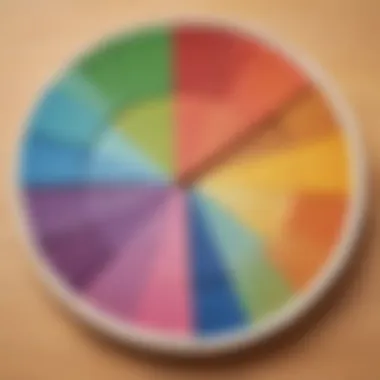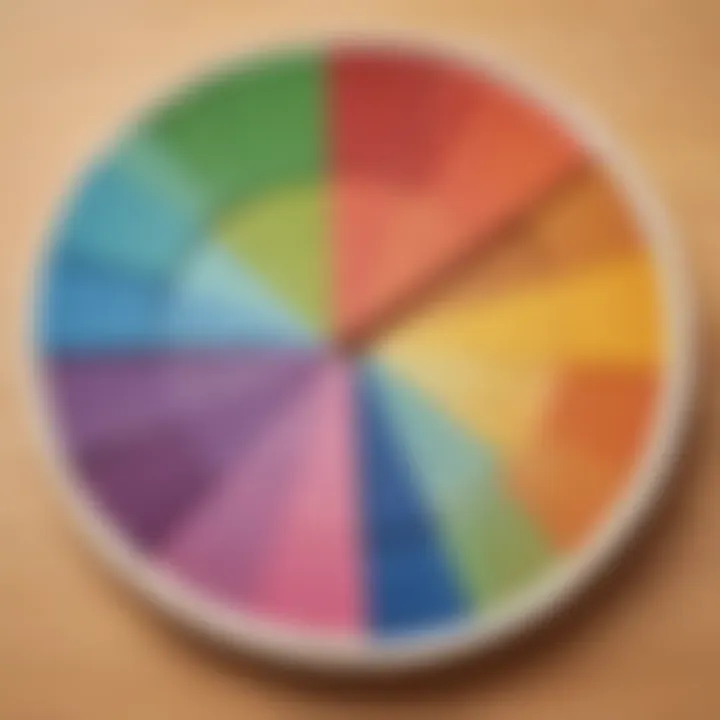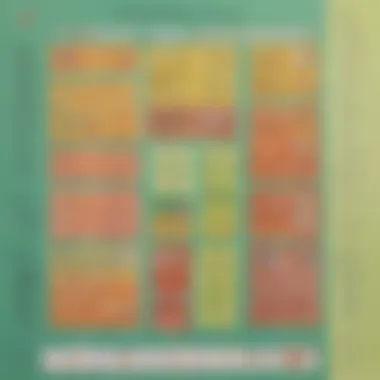Understanding Fractions, Decimals, and Percents


Intro
Mathematics often presents challenges, especially when it comes to understanding the relations between fractions, decimals, and percents. These three concepts are foundational to numerous mathematical applications and everyday situations. By recognizing how they connect, learners can enhance their problem-solving skills and gain confidence in their mathematical abilities. This guide aims to provide clarity on these topics while offering methods to teach them effectively.
Understanding these concepts is not just for academic purposes. They are relevant in daily life, influencing everything from budgeting to shopping discounts. Through engaging activities and resources, children can learn to grasp these relationships in a fun and impactful manner. In essence, this article will cover the following topics: the definition of each concept, their interrelationships, effective teaching strategies, and resources such as worksheets designed for practical application.
Prelude to Mathematical Concepts
Mathematics encompasses various fundamental concepts that are pivotal for understanding broader mathematical principles. Among these, fractions, decimals, and percents are critical. They serve as essential tools in both academic and real-world applications. Mastering these concepts equips learners with the ability to make sense of complex numerical information.
Understanding the role of fractions, decimals, and percents aids in developing quantitative literacy. This literacy is crucial in everyday tasks, such as budgeting, shopping, and cooking. The ability to navigate these mathematical forms also fosters analytical thinking and problem-solving skills, essential for many professions.
Importance of Mastering Fractions, Decimals, and Percents
The mastery of fractions, decimals, and percents is not simply an academic requirement; it is a key life skill. Each of these concepts offers unique insights and applications in daily life. For instance, fractions are often used in cooking and measuring, where parts of a whole are essential.
Decimals provide precision in measurements. They allow for more exact calculations in fields such as science and engineering. Meanwhile, percents have widespread usage in finance, helping individuals understand discounts, taxes, and interest rates.
Here are several benefits of mastering these concepts:
- Enhanced Problem Solving: Understanding how to manipulate these forms allows for more effective solutions to math problems.
- Informed Decision-Making: Individuals can make better choices regarding finances and other quantitative measures when they grasp these concepts.
- Academic Success: Mastery contributes to higher performance in mathematics and related subjects.
Interconnectedness of These Concepts
Fractions, decimals, and percents are interconnected in ways that may not be immediately apparent. Each concept represents a different method of expressing numerical relationships, but they all refer to the same underlying idea: part-whole relationships.
For example, the fraction 1/2 can be expressed as 0.5 in decimal form and 50% in percent form. This transformation between forms is essential in mathematical literacy, allowing individuals to choose the most appropriate format for the context.
Understanding this interconnectedness encourages deeper learning. It allows students to see not just isolated numerical values, but rather part of a wider mathematical landscape. This perspective can foster greater curiosity and a more profound understanding of mathematics as a whole.
"Mathematics is not about numbers, equations, computations, or algorithms: it is about understanding."
Definition of Fractions
Understanding fractions is fundamental in mathematics. Fractions serve as a bridge between whole numbers and real-world concepts such as sharing, division, and even measurement. This section helps to clarify how fractions are defined, their components, and their various types. Mastering fractions is beneficial in higher mathematics and everyday life, as they often reflect proportions that relate to various contexts, such as cooking, budgeting, and carpentry.
Understanding Numerators and Denominators
A fraction comprises two main parts: the numerator and the denominator. The numerator is the top number, indicating how many parts of a whole are considered. Conversely, the denominator is the bottom number, representing the total number of equal parts that the whole is divided into.
For example, in the fraction 3/4, the numerator is 3, meaning three parts are being considered, while the denominator is 4, indicating that the whole is divided into four equal parts. Understanding this relationship is crucial. It provides insights into the concept of parts to a whole.
Moreover, recognizing the role of numerators and denominators lays the groundwork for performing operations with fractions, such as addition, subtraction, multiplication, and division. When engaging with fractions, students should practice visualizing these components, perhaps through diagrams or pie charts. This visualization aids in comprehending fraction concepts.
Types of Fractions: Proper, Improper, and Mixed Numbers
Fractions categorize into three main types: proper fractions, improper fractions, and mixed numbers.
- Proper Fractions: These consist of a numerator smaller than the denominator. For instance, in the fraction 2/5, the numerator 2 is smaller than the denominator 5.
- Improper Fractions: In contrast, these fractions have a numerator larger than or equal to the denominator, such as 5/3 or 4/4. This means that they represent quantities equal to or greater than one whole.
- Mixed Numbers: A mixed number contains both a whole number and a proper fraction. An example is 2 1/4, which represents two whole parts plus an additional quarter part.
Understanding these types aids in recognizing how to manipulate fractions in various mathematical operations. Knowing when to convert between these forms can enhance problem-solving skills and mathematical reasoning. It's also important to understand how to visualize these fractions effectively using visuals like number lines or pie charts.
"Fractions are essential for understanding relationships among quantities."
Engaging with fractions not only facilitates mathematical capabilities but also nurtures a foundational understanding that supports other concepts in mathematics like decimals and percents. Mastering the definition and types of fractions thus lays an essential groundwork for the progression into more advanced mathematical studies.
Exploring Decimals
Decimals play a vital role in mathematics, often serving as a bridge between whole numbers and fractions. In this section, we will delve into the significance of decimals and their applications. Understanding decimals enables a more profound comprehension of numerical relationships, which is essential for children as they progress in their mathematical education.
Definition and Place Value System
A decimal is a fraction whose denominator is a power of ten. It consists of two parts: the whole number part and the decimal part, separated by a decimal point. For example, in the number 4.56, the digit 4 represents four whole units, while the digits 56 represent the fractional part, which is equivalent to fifty-six hundredths.
The place value system is essential for comprehending decimals. Each digit's position indicates its value:
- The digit to the left of the decimal point represents whole numbers.
- The first digit to the right of the decimal point represents tenths.
- The second digit after the decimal point represents hundredths.
- The third digit represents thousandths, and so forth.
This hierarchical structure is crucial for both the arithmetic operations involving decimals and in every day numeracy.
Comparing Decimals and Whole Numbers
When comparing decimals to whole numbers, it is crucial to visualize the relationship between them. Decimals can represent values that are less than one, leading to confusion for those who mainly focus on whole numbers.
To effectively compare, one can consider the following points:


- Place Value: Start comparing from the leftmost digits. A larger digit at a higher place value indicates a larger overall number
- Conversion: Sometimes, it helps to convert whole numbers into decimal form. For instance, 3 can be written as 3.0, allowing for a direct comparison to decimal values like 2.5.
Using visual aids like number lines can assist in illustrating decimal placements relative to whole numbers.
Understanding how decimals function alongside whole numbers will enhance numerical fluency, critical for academic success. The ability to manipulate decimals will also be beneficial in several real-life situations, such as budgeting and measurement calculations.
Understanding Percents
Understanding percents is essential in numeracy. They offer a straightforward way to express ratios and comparisons. In many situations, percentages provide a common ground for interpreting data through a familiar frame of reference. This section explores the definition and calculation of percents, as well as their practical applications. Such comprehension can bolster confidence in mathematical reasoning across real-life scenarios.
Definition and Calculation of Percents
A percent is a way to express a number as a fraction of 100. The term comes from the Latin phrase "per centum," which means "by the hundred." Therefore, when one says 50 percent, it indicates 50 out of every 100 parts.
To calculate a percentage, the formula is simple:
- Percentage (%) = (Part / Whole) × 100
For instance, if a student scores 18 out of 20 on a test, the calculation will be:
- (18 / 20) × 100 = 90%
This calculation shows that the student achieved 90 percent on the test. The clear definition and method of calculating can aid learners in grasping the core concept of percents.
Real-Life Applications of Percents
Percents are not just confined to textbooks. Their applications resonate throughout daily life, making understanding this concept quite valuable. Here are some aspects where percents often show up:
- Financial Contexts:
- Statistics and Data:
- Education:
- Interest Rates: Banks frequently advertise loans and savings with interest rates presented as percents. Knowing how to interpret these numbers aids in making informed financial decisions.
- Sales and Discounts: When shopping, discounts are often displayed as percentages. Understanding how this affects the total price impacts consumers significantly.
- Surveys and Polls: Results of surveys frequently come reported in percentages. Analyzing these gives insight into trends and public opinion.
- Grading Systems: Academic performance is often measured in percents. Knowing how to interpret these numbers helps students monitor their progress effectively.
"Mastering the concept of percents equips individuals with essential skills for financial literacy and critical thinking in many aspects of life."
Thus, recognizing the significance of percents leads to improved decision-making and a deeper understanding of quantitative information.
Conversions Between Fractions, Decimals, and Percents
Understanding how to convert between fractions, decimals, and percents is essential in mathematics. Each of these forms provides a unique perspective on numbers and quantities. Knowing how to switch between them allows for a more flexible approach to problem-solving. This part of the guide emphasizes the significance of these conversions not just as a tool for calculations but also as a way to build a deeper comprehension of numerical relationships.
Conversions facilitate progress in various real-world contexts. For example, when shopping, seeing a discount in percent can be converted to a decimal for easier calculation of the final price. Likewise, representing fractions as decimals can assist in understanding proportions more clearly. Students and educators benefit from mastering these conversions, as they enhance mathematical fluency and confidence.
Fraction to Decimal Conversion Methods
Converting a fraction to a decimal involves simple division. The numerator is divided by the denominator. This process is straightforward, yet it is fundamental for understanding how fractions relate to decimal values.
For example, the fraction 3/4 is converted as follows:
- Calculate 3 divided by 4, which gives 0.75.
Keep in mind:
- If the fraction has a denominator of 10, 100, or 1000, the conversion is often easier. For instance, 25/100 is equivalent to 0.25.
The key points to remember for this conversion are:
- Divide the top number by the bottom number.
- Round the decimal if necessary, depending on the context.
Using calculators can help in checking these conversions, but understanding the concept ensures more reliable knowledge of numerical relationships.
Decimal to Percent Conversion Techniques
To convert a decimal to a percent, simply multiply the decimal by 100. This yields the percentage equivalent of the decimal. Additionally, it's important to include the percent symbol (%) after the number.
For example:
- Take the decimal 0.85. By multiplying by 100, you get 85%.
This method can be summarized as follows:
- Multiply the decimal by 100.
- Add a percent sign to indicate it's a percent.
A useful tip is to remember that moving the decimal point two places to the right also converts a decimal to a percent. However, precision matters; ensure correct placement especially for longer decimals.


Percent to Fraction Conversion Steps
Converting a percent to a fraction is a bit different. Start by writing the percentage as a fraction over 100. Next, simplify the fraction if possible. In this case, recognizing common factors will facilitate easier simplification.
For instance:
- Convert 60% to a fraction: 60/100.
- Simplifying gives you 3/5 as the final answer.
Here's how to do it:
- Write the percent as a fraction over 100.
- Simplify the fraction, if necessary.
This method provides clarity by returning to the foundational concept of fractions. It reinforces an understanding of how percents function within the larger framework of mathematics.
Understanding conversions between these three numerical forms plays a vital role in daily calculations and academic achievement.
In summary, mastering these conversion methods empowers learners to navigate mathematical challenges more effectively. The ability to fluidly interchange fractions, decimals, and percents opens various avenues in both academics and practical scenarios.
Worksheets for Learning Fractions, Decimals, and Percents
Worksheets serve as an essential tool for mastering the interconnected concepts of fractions, decimals, and percents. They provide a structured way for children to practice and solidify their understanding of these mathematical principles. Worksheets can help not only in reinforcing concepts but also in developing problem-solving skills. They are designed to cater to different learning levels, which means that every child can benefit regardless of their current understanding.
The importance of using worksheets cannot be overstated. They offer focused practice that is crucial in the early stages of learning. Engaging with different types of problems enables students to see how these mathematical forms interact with each other. It also allows them to apply their knowledge in practical scenarios. This makes math seem more relevant and accessible to children, which can boost their confidence and interest in the subject.
Types of Worksheets Available
Various types of worksheets are available for teaching fractions, decimals, and percents. Each type targets specific learning objectives. Some common types include:
- Practice Worksheets: These provide direct practice with basic calculations involving fractions, decimals, and percents. They can range from simple to more complex problems.
- Word Problems: These worksheets present math in real-world contexts. This encourages critical thinking and application of knowledge in daily situations.
- Puzzle Worksheets: These worksheets include riddles or math puzzles that help make learning enjoyable while reinforcing key concepts.
- Comparative Worksheets: This type focuses on comparing fractions to decimals and percents. They help students visualize the relationships among them.
Children can benefit from a variety of these worksheets depending on their learning styles and preferences. Choosing the right type can further enhance their understanding and retention of the material.
How to Utilize Worksheets Effectively
To get the most out of worksheets, it is important to use them in a strategic way. Here are some tips:
- Set Clear Objectives: Determine what specific skills or concepts you want the child to focus on. This helps in choosing the appropriate worksheets.
- Start with Basics: Begin with simpler tasks to build confidence. Gradually increase the difficulty as the learner shows improvement.
- Provide Feedback: After completing worksheets, review the answers together. Highlight areas of success and discuss mistakes for deeper understanding.
- Encourage Discussion: Allow children to explain their reasoning. This reinforces their learning and helps in identifying any misunderstandings.
- Integrate with Other Activities: Use worksheets alongside hands-on activities, such as using manipulatives or digital tools. This well-rounded approach caters to multiple learning preferences.
By utilizing worksheets with intention, parents and educators can create a more engaging learning experience for children, allowing them to grasp fractions, decimals, and percents with clarity and confidence.
Strategies for Teaching These Concepts
Teaching fractions, decimals, and percents effectively is essential in fostering a strong foundational understanding of mathematics among children. This section explores various strategies that enhance comprehension and retention. The goal is to present topics in an engaging and accessible manner. By employing diverse teaching techniques, educators can cater to different learning styles and ensure that concepts resonate with their students.
Incorporating Visual Aids and Manipulatives
Visual aids and manipulatives are powerful tools in teaching mathematical concepts. They help in creating a concrete representation of abstract ideas, making them easier to comprehend. Using objects, such as pie charts, fraction strips, or base ten blocks, allows students to visualize relationships between fractions, decimals, and percents.
- Fractions: Create a pie chart to show how fractions represent parts of a whole. Color-coded segments will help students grasp the idea of divided portions.
- Decimals: Use base ten blocks to illustrate the decimal system. Each block can represent a whole number, and smaller sections can represent tenths and hundredths.
- Percents: Demonstrate percents with a percentage slider or a hundred-grid chart. This way, students can see how percentages are related to fractions and decimals visually.
Utilizing these visual tools not only aids comprehension but also caters to visual learners. This can boost confidence as students begin to connect the dots between different forms of numbers.
Engagement Through Interactive Activities
Interactive activities are crucial for promoting active involvement in learning. They encourage students to engage with mathematical concepts on a deeper level. Here are some effective interactive methods:
- Group Work: Organize students into small groups where they can discuss their understanding of fractions, decimals, and percents. Encouraging peer-to-peer explanations can lead to greater insights.
- Hands-On Projects: Assign tasks that cover real-world applications of these concepts. For example, students can measure ingredients for a recipe, converting measurements between fractions and decimals.
- Games and Technology: Utilize educational games or apps that focus on these mathematical concepts. Combining technology with play makes learning enjoyable and stimulating.
"Engagement in maths not only enhances understanding but also builds a love for learning."
The key is to make math a living subject that is relevant to students’ everyday experiences. Interactivity fosters curiosity and reinforces concepts through practice, ultimately leading to mastery.
Evaluating Student Understanding
Evaluating student understanding is a critical aspect when teaching fractions, decimals, and percents. The effectiveness of instruction depends significantly on teachers' abilities to assess how well their students grasp these foundational mathematical concepts. Proper evaluation not only helps in identifying learning gaps but also in adapting teaching methods to meet the students' unique needs. It is crucial to recognize that each student learns at their own pace, and understanding the concepts may require different approaches.
Assessment can take many forms. Tests and quizzes might offer a snapshot of students' knowledge, yet they do not tell the whole story. Observations during class activities and discussions also play an essential role in understanding how students approach problems involving fractions, decimals, and percents. Engaging in informal assessments, such as questioning or interactive discussions, can contribute richly to evaluating comprehension. These methods provide insights into students' thought processes, allowing educators to adjust their strategies accordingly.
Benefits of Evaluating Student Understanding
- Helps in recognizing specific areas of difficulty
- Enables personalized feedback and support
- Guides the teacher's future lesson planning
- Builds student confidence when they see progress
Thorough evaluation informs the educational approaches used, creating a more efficient learning environment. Teachers should embrace different strategies to meet diverse learning styles, specifically when discussing fractions, decimals, and percents.
"Assessment is an ongoing process that's crucial for understanding student learning."
Assessments for Fractions and Decimals


Assessing understanding of fractions and decimals is essential for ensuring students can perform these operations competently. Various forms of assessment can gauge student proficiency effectively, ranging from traditional methods to alternative forms.
1. Quizzes and Tests: These usually consist of multiple-choice, fill-in-the-blank, or direct computation problems that assess students' ability to apply their knowledge of fractions and decimals.
2. Practical Applications: Present students with real-world scenarios. For example, ask them to calculate discount amounts or compare prices using decimals and fractions.
3. Peer Teaching: Encourage students to explain concepts to their peers, demonstrating their understanding.
Assessments should always align with the learning objectives, focusing on both computational skills and conceptual understanding. This method enhances retention and supports overall learning impact.
Tracking Progress with Percents
Monitoring student progress with percents is a vital part of the educational experience. Since percents often relate to topics like finance and data interpretation, tracking their understanding can prepare students for future real-world applications.
Educators can employ several strategies to assess and track progress:
- Data Analysis Exercises: These can include interpreting data from charts or graphs. Students should be able to identify and calculate the percent values represented.
- Project-Based Learning: Design projects that require students to analyze real-life situations involving percentages, such as budgeting or shopping.
- Regular Feedback Mechanisms: Implement check-ins that allow students to voice their understanding or questions regarding percents.
It is advisable to provide supportive feedback, highlighting improvements while pointing out areas that need revisiting. Consistent tracking not only helps teachers evaluate instructional efficacy but also nurtures student confidence by showing them their progress over time.
Common Misconceptions and Challenges
Understanding fractions, decimals, and percents can be difficult for many learners. This section addresses the common misconceptions and challenges faced. Recognizing these issues is essential for both educators and parents. Without awareness of these pitfalls, students might struggle unnecessarily, leading to a lack of confidence in their mathematical skills.
Identifying Misunderstandings in Fractions
One frequent misunderstanding involves the concept of fractions themselves. Many learners view fractions as less than a whole number without grasping that fractions represent parts of a whole. For example, a common error occurs when students think that the larger the numerator, the larger the fraction, even when the denominator is also larger. In this case,
- 3/4 is larger than 5/8, although 5 is greater than 3.
It requires instruction to help learners see that fractions depend on both parts.
Another issue is that students might mistake improper fractions for subjectivity to be avoided. They might prefer mixed numbers, not realizing their equivalent value. Encouraging students to practice with both types helps build their understanding.
Lastly, learners often forget about the role of the denominator in defining the fraction's value. This leads to confusion when operations, like simplifying fractions, are introduced. Good teaching strategies can include visual aids to illustrate these concepts, making the fractions more tangible.
Addressing Decimal Confusion
Decimals also present several challenges. A critical misunderstanding arises from place value. Children sometimes reverse the meaning of decimal places, thinking that moving to the right increases the value, instead of decreasing it. For instance, in the decimal 0.2, it is easy to confuse it with 2.0, not recognizing that the position dictates the value.
To clarify this point, educators can use number lines to demonstrate the impact of decimal placement.
Additionally, students encounter difficulties when converting decimals to fractions. They may struggle to see that 0.75 is equivalent to 75/100. This is where hands-on practice becomes useful in reinforcing understanding.
One effective approach is to use real-life examples that connect decimals to everyday use, such as money. Children can easily relate to using decimals when shopping. Further, creating simple worksheets focusing on decimal comparisons can help strengthen their skills in this area.
Educators and guardians should be mindful of these common challenges, providing consistent support and practice to help learners build a solid foundation in fractions and decimals.
Resources for Further Learning
Resources for further learning play a crucial role in mastering mathematical concepts such as fractions, decimals, and percents. Access to quality materials can significantly enhance comprehension and retention. With the right books, online platforms, and community support, learners can progress at their own pace, reinforcing their understanding through varied approaches.
These resources are valuable for parents, teachers, and students alike, serving as tools to expand on the foundational knowledge already acquired. By integrating diverse sources into their study routines, learners can navigate the complexities of these interrelated topics with confidence. This section explores both recommended books and online resources, as well as community support options available for learners seeking to deepen their understanding.
"Learning is a treasure that will follow its owner everywhere."
Recommended Books and Online Resources
Investing in good literature can provide solid groundwork. Several books and online resources focus on practical strategies for understanding and teaching fractions, decimals, and percents. Here are some effective recommendations:
- Books
- Online Resources
- "Fractions, Decimals, and Percentages: A Complete Guide for Teachers" by Annette S. Murdock – This book offers methods and insights for educators to teach these concepts effectively.
- "Understanding Fractions and Decimals" by Rebecca A. Bader – Focuses on allowing students to grasp these concepts with interactive exercises.
- Khan Academy (khanacademy.org) – Provides engaging videos and exercises on fractions, decimals, and percents for all grade levels.
- Math is Fun (mathsisfun.com) – This website contains clear explanations and practice problems designed for children, offering a playful approach to learning.
These resources facilitate the learning experience by catering to various learning styles and preferences, ensuring that students receive well-rounded support.
Community Support and Tutoring Options
Learning can often be enhanced through community support and tutoring. Engaging in collaborative learning environments allows students to benefit from shared insights, diverse strategies, and social interaction. Here are some community-focused options:
- Local Tutoring Centers
- Online Tutoring Platforms
- Community Groups and Forums
- Organizations like Sylvan Learning and Kumon offer tailored tutoring sessions focusing on individual needs.
- Sites such as Chegg Tutors and Tutor.com provide immediate access to qualified tutors who can explain concepts on a one-on-one basis.
- Reddit and other online forums can serve as platforms for students to ask questions, share resources, and collaborate with peers facing similar learning challenges.
Accessing community support not only enhances understanding but also builds confidence through social learning experiences.
In summary, utilizing diverse resources for further learning is essential for mastering the intricacies of fractions, decimals, and percents. Strategic integration of books, online resources, and community support can transform the learning journey, making it more effective and enjoyable.



